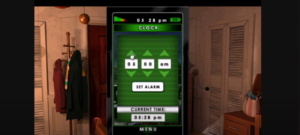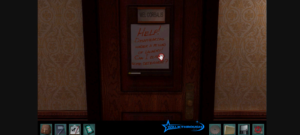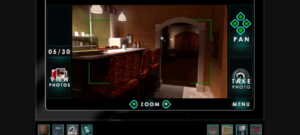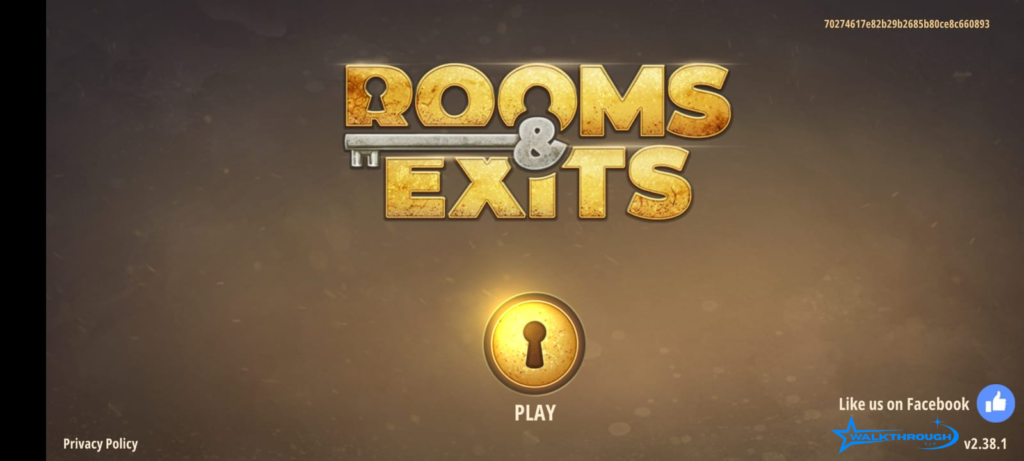
Welcome to the ultimate Rooms and Exits Walkthrough – your one-stop guide to mastering every puzzle, unlocking every door, and escaping each cleverly designed room in this thrilling mystery game.
Rooms and Exits, developed by Webelinx Games, is a captivating escape room puzzle adventure that puts your logic, observation, and critical thinking skills to the test. You step into the shoes of Detective Fiona Fox, a brilliant investigator on a mission to uncover secrets hidden behind locked doors and twisted mysteries. Every chapter presents a new location, every level a new case, and every puzzle a step closer to the truth.
Whether you’re a first-time player or someone stuck on a specific level, this walkthrough is crafted to guide you through the entire game one chapter, one room at a time.
🔍 What Is “Rooms and Exits”?
Rooms and Exits is a mobile puzzle escape game that mixes classic room escape gameplay with story-driven chapters and high-quality visuals. Unlike traditional games in the genre, this title integrates layered storytelling with logic-based puzzles and hidden-object scenes, making every level feel like part of a larger detective saga.
With each room designed uniquely, players are constantly challenged by new puzzle formats from codebreaking to object combination, pattern recognition, and memory tasks. There’s no hand-holding here you’re meant to think, explore, and experiment.
🎯 Purpose of The Rooms and Exits Walkthrough
This walkthrough is built with three core goals in mind:
- Help You Progress Smoothly
Get step-by-step help for each level, so you’re never stuck for too long. - Save Time & Frustration
Skip the trial-and-error process by following proven solutions and tips. - Enhance Your Experience
Understand the logic behind puzzles, uncover hidden clues, and enjoy the game’s narrative more deeply.
Each level guide includes:
- Main objectives
- Complete puzzle solutions
- Inventory item locations
- Useful strategies and common mistakes
- Screenshots or visual aids (if applicable)
🧩 Who Should Use This Guide?
This walkthrough is ideal for:
- New players just starting the game
- Casual gamers who enjoy story-rich puzzles
- Hardcore completionists aiming for 100% level clearance
- Anyone stuck on a particularly tricky puzzle
Whether you’re solving your first lock in the “Warm Up” level or tackling the multi-step challenges of later chapters, this guide will be your best detective partner.
🗺️ What You’ll Find Inside
This guide covers:
- Every Chapter and Level in the game
- All types of puzzles and mini-games
- Pro tips for tricky sections
- A growing section for future updates
- A community comment area where you can ask questions or help others
So grab your magnifying glass, Detective it’s time to solve some mysteries. 🕵️♂️
🎮 Game Basics & Features
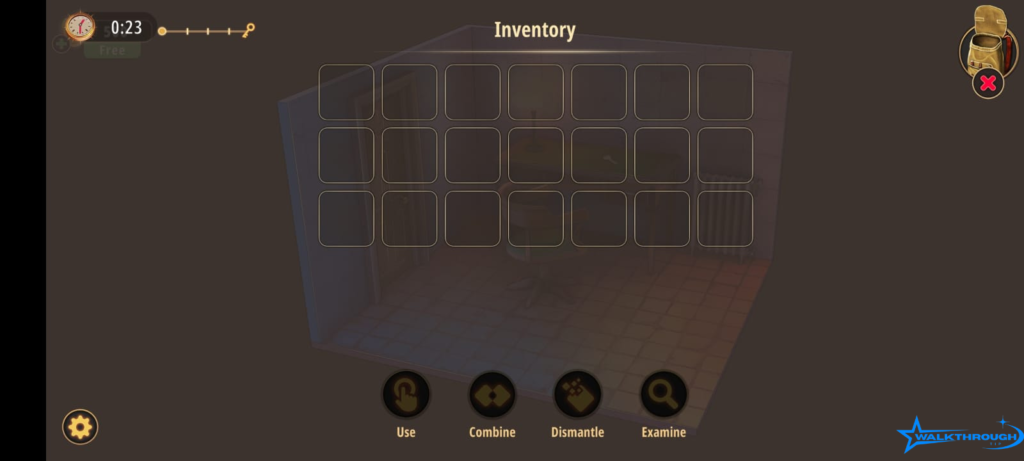
Rooms and Exits isn’t just about moving from one room to another it’s an intricate puzzle adventure where every feature has been designed to challenge and engage your mind. Before diving into the rooms and exits walkthrough, it’s important to understand the core mechanics and features that make the game so immersive.
How the Game Works
At its heart, the game combines elements of traditional escape rooms with modern puzzle mechanics. Each room or level is a self-contained mystery where you must explore your surroundings, interact with objects, and solve puzzles to progress. The gameplay rewards sharp observation and logical thinking.
- Navigation & Interaction:
The intuitive touch-based interface allows you to tap, swipe, and zoom in on objects. This means you can inspect every detail, ensuring nothing is missed that could help solve a puzzle. - Puzzle Variety:
The game features a mix of challenges including:
- Code Breakers: Use clues found within the room to decode secret numbers or words.
- Hidden Object Searches: Find subtle differences in cluttered scenes.
- Logical Puzzles: Arrange items or follow clues to unlock doors.
- Pattern Recognition: Identify sequences or visual patterns essential for progression.
- Code Breakers: Use clues found within the room to decode secret numbers or words.
- Inventory & Item Management:
Items collected during gameplay are stored in an inventory system. Knowing how to combine or use these items is often the key to unlocking new areas. The game encourages you to experiment, which is where our detailed walkthrough steps come in handy.
Essential Game Features
The game is loaded with features that enhance both the challenge and the overall experience:
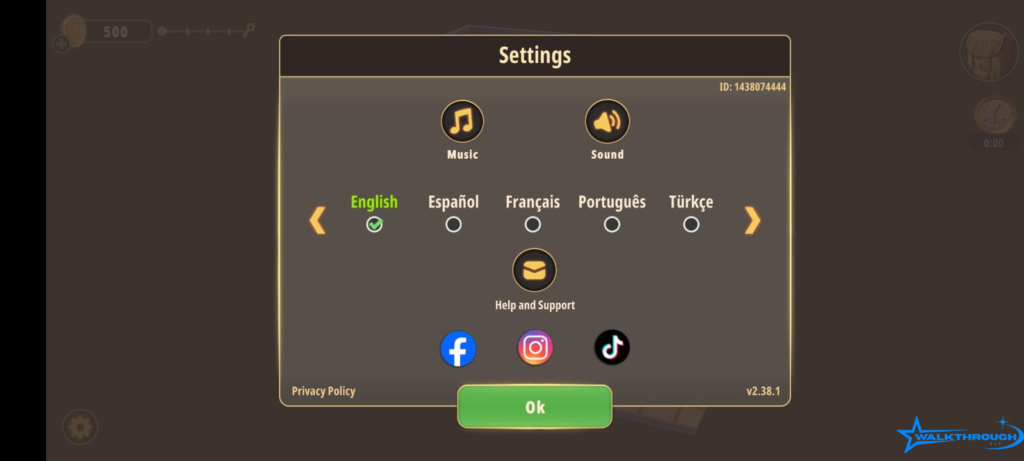
- Realistic Environments:
Each level is designed with meticulous detail, from the textures of the room walls to the objects scattered around. This not only makes the game visually appealing but also plays a crucial role in the clues provided for solving puzzles. - Dynamic Storytelling:
While puzzles are at the forefront, the narrative unfolds as you progress. Every chapter introduces new characters, plot twists, and mysteries that deepen the game’s lore. This narrative layer keeps players engaged, making every solved puzzle feel like a piece of a larger story. - Progressive Difficulty:
The game is structured to gradually ramp up the complexity of puzzles. Early levels serve as tutorials, easing players into the mechanics, while later levels challenge even the most experienced puzzle enthusiasts with multi-step puzzles and hidden clues. - Interactive Hints System:
For those moments when you’re truly stuck, the game offers a subtle hint system. Rather than giving away the complete solution, hints are designed to nudge you in the right direction helping you learn from your mistakes and develop your problem-solving skills. - User-Friendly Interface:
Despite the game’s depth, the interface remains clean and accessible. Menus, inventory screens, and in-game maps are all designed with usability in mind, ensuring you spend more time solving puzzles and less time navigating through clutter.
Key Points to Remember
- Exploration is Essential:
Every corner of each room is designed to offer clues. Rushing through levels might cause you to miss critical details, so take your time and inspect your surroundings. - Clues Come in Many Forms:
Don’t just focus on obvious puzzles; sometimes the most important clues are hidden in plain sight within the environment or in the dialogue between characters. - Inventory Management:
How you organize and use collected items is a crucial strategy element. Some puzzles might require combining items in non-obvious ways. - Adapting to Difficulty:
As the game progresses, be prepared for puzzles that require multi-step thinking. Patience and a systematic approach are your best tools.
By understanding these foundational aspects, you’re better equipped to tackle the detailed walkthroughs for each level. Each section of our guide will build on these basics, offering step-by-step solutions, tactical advice, and insights that cater to both new and seasoned players.
📋 Chapter Overview Table
Explore each chapter below and click on any level to dive into its detailed rooms and exits walkthrough with step-by-step solutions. We update this page regularly as new chapters are released, so be sure to bookmark it!
🔹 Chapter 1 – Mystery in the Mall
Enter the mall, where each store hides secrets waiting to be unraveled. Perfect for beginners, but don’t be fooled—challenges escalate quickly.
- Warm-Up
- Flower Shop
- Beauty Salon
- Hardware Store
- Bookstore
- Bakery
- Fashion Store
- Toy Store
- Furniture Store
- Gym
- Candy Shop
- Food Court
- Pet Shop
- Indoor Playground
- Restaurant
- Opening Soon
- Jewelry Store
- Grocery Store
- Exchange Office
- Cinemas
- Art Supplies Store
- Shoe Store
- Sports Store
- Coffee Shop
- Optical Store
- Household Appliances
- Print Shop
- Cell Phone Store
- Pharmacy
- Restrooms
- Parking
- Halloween Special Level
🔹 Chapter 2 – Murder Dressed in White
Put on your detective hat—this chapter takes you through a mysterious mansion filled with crime scenes, clues, and twists.
- Dining Room
- Living Room
- Study Room
- Guest Toilet
- Workshop
- Guest Bedroom
- Master Bathroom
- Kids Playroom
- Backyard
- Garden
- Kitchen
- Dining Room
- Kids Bedroom 1
- Storage Room
- Garage
- Attic
- Terrace
- Basement
- Garden Shed
- Kids Bedroom 2
- Hobby Room
- Master Bedroom
- Entertainment Room
- Hallway
🔹 Chapter 3 – Pharaoh’s Bride
Travel back in time and explore ancient secrets hidden in historical exhibits, museums, and tombs.
- Pharaoh’s Tomb
- Power and Security
- The Office
- Planetarium
- Dino World
- Aeronautics Museum
- Art Museum
- Illusions and Puzzles
- Turkish Exhibition
- Botanical Garden
- Music Museum
- Medical History
- Mayas and Incas
- Special Chapter – Christmas Wonder
🔹 Chapter 4 – Wicked Games
A psychological thrill begins—step into eerie rooms filled with illusions, cryptic clues, and unsettling mysteries.
- Escape Room
- William’s Apartment
- High School
- Yacht
- Amusement Park
- The Game Night Agency
- Log Cabin
- Junkyard
- Train Station
- Lighthouse
🔹 Chapter 5 – Death on the Dance Floor
The party turns deadly in this gripping chapter full of glamorous settings and grim surprises.
- Club Entrance
💡 Tips:
- Each chapter offers a unique visual and puzzle-solving experience.
- Try to solve puzzles before using hints—it makes the experience more rewarding.
- We recommend completing the levels in order for a smoother storyline flow.
- Don’t forget to check back here as we add more walkthroughs weekly!
🔍 Special Sections for Extra User Value
Enhance your gameplay with these extra guides and resources. Whether you’re looking for hidden gems, common puzzle types, or practical tips, these sections are here to ensure you’re fully prepared for every challenge in Rooms and Exits.
1. Hidden Items Guide
In Rooms and Exits, hidden items aren’t just collectibles they often hold the key to solving puzzles and unlocking secret paths. In this guide:
- Comprehensive List:
Discover all the hidden objects scattered throughout each level. This list is organized by chapter and level for easy reference. - Location Tips:
Get detailed hints on where to look for hidden items. For example, check behind books, under furniture, or within decorative objects. - Item Utility:
Understand the significance of each item and how it can be combined with others in your inventory to solve puzzles.
Key Point: Hidden items can sometimes serve as backup clues if the main puzzle solution isn’t immediately clear. Use them strategically to unlock additional hints or shortcuts.
2. Puzzle Index
Not all puzzles are created equal. The Puzzle Index categorizes the various types of challenges you’ll encounter, helping you quickly recognize and approach them with confidence:
- Code Breakers:
Puzzles that require deciphering numerical or letter codes. Tips include pattern recognition and testing common combinations. - Hidden Object Challenges:
Tasks where objects are concealed within cluttered environments. Look closely at every corner and surface. - Logic & Sequence Puzzles:
These puzzles require you to arrange items or follow a sequence indicated by the game’s clues. Patience and systematic thinking are essential. - Pattern Recognition:
Identify recurring symbols, colors, or shapes to unlock doors or reveal hidden messages.
Key Point: Familiarity with these puzzle types will help you approach each challenge methodically, saving time and reducing frustration.
3. Tips & Tricks Section
Elevate your gameplay with practical strategies and insider tips:
- Observation Techniques:
Take your time exploring every detail. Sometimes the smallest clue can make the difference between progress and a dead-end. - Inventory Strategies:
Organize your collected items logically. Review your inventory frequently as combining items often leads to breakthroughs in puzzles. - Effective Use of Hints:
Use in-game hints wisely. They’re designed to nudge you toward the solution rather than giving it away completely, so use them only when truly stuck. - Time Management:
For more challenging puzzles, consider taking a break and revisiting the problem with a fresh perspective. This can often help in spotting overlooked details. - Community Insights:
Engage with the walkthrough’s comment section. Share your strategies and learn from other players’ experiences.
Key Point: Combining these tips with careful observation can greatly improve your problem-solving efficiency, ensuring a smoother and more enjoyable experience.
4. Frequently Asked Questions (FAQ)
To address common queries and provide quick solutions, the FAQ section covers:
Q:Why should I use a Rooms and Exits walkthrough instead of playing without hints?
A: A Rooms and Exits walkthrough helps you avoid frustration by guiding you through tricky puzzles, especially if you’re stuck. It’s perfect for players who want to enjoy the storyline without getting held up by difficult levels.
Q: Can I replay levels to improve my score or find missed clues?
A: Yes, levels can be replayed to uncover additional items or optimize your solution approach.
Q: Where can I find a complete Rooms and Exits walkthrough for Chapter 1 Level 11?
A: You can find a detailed Rooms and Exits walkthrough for Chapter 1 Level 11 right here in this article. It includes step-by-step instructions to solve all puzzles and escape successfully.
Q: How does the hint system work?
A: Hints are available to guide you without revealing the complete solution, encouraging independent problem-solving while providing support when needed.
Q: How many levels are there in total?
A: The game features multiple chapters, each with a distinct set of levels that progressively increase in difficulty.
Q: Is there an option to save progress or sync between devices?
A: Yes, the game supports a save system, and progress can be synced across devices in supported platforms.
Key Point: The FAQ section is updated regularly based on user feedback, ensuring that the most common issues are promptly addressed and resolved.
🧠 Puzzle Types & Solutions Guide
The brilliance of Rooms and Exits lies in its variety of puzzles. No two rooms feel the same, and even repeated puzzle mechanics are presented with creative twists. This section breaks down the most common puzzle types, explains how they work, and offers example solutions based on typical patterns found throughout the game.
Understanding these puzzle archetypes will help you anticipate what to look for, speed up your problem-solving, and increase your overall success rate.
🔐 1. Code Locks & Keypads
These puzzles often involve entering a combination of numbers or symbols into a panel to unlock a drawer, door, or box.
Common Clues:
- Numbers hidden in the environment (on clocks, books, paintings).
- Patterns from objects (e.g., color-to-number associations).
- Math-based clues (additions, sequences, logic puzzles).
Example:
You find a sticky note that says “Red + Blue = 9.” Elsewhere, three paint cans labeled Red, Blue, and Green are found. You must deduce the value of each and use it to open a keypad.
Pro Tip:
Always look around for number sequences or clues nearby code pads are rarely stand-alone. They depend on context clues from the same room.
🧩 2. Pattern Matching & Symbol Sequences
These puzzles require you to recognize visual or logic-based patterns in a series of symbols or images.
Common Variations:
- Matching symbols from a clue found in a book or paper.
- Rotating tiles to align patterns.
- Selecting items in a specific order.
Example:
A wall puzzle shows six geometric shapes. A note elsewhere reveals a sequence: Circle → Triangle → Square. You must touch the shapes in order to progress.
Pro Tip:
Pay attention to color, size, rotation, and orientation. The smallest visual change can affect the solution.
🧰 3. Object Combination Puzzles
Some puzzles require combining two or more collected items from your inventory to create a new item or trigger a puzzle solution.
How It Works:
- Drag one inventory item onto another (e.g., combine wire + battery = powered device).
- Use an item on a part of the room (e.g., use screwdriver on panel).
Common Examples:
- Key + Handle → Door Opener
- Matches + Candle → Reveal hidden clues in the dark
Pro Tip:
If an item seems useless, think about what it might logically combine with. Try everything there’s no penalty for testing combinations.
🧩 4. Hidden Object & Search Puzzles
These puzzles test your observation skills rather than logic.
Tasks Might Include:
- Spotting differences between two similar scenes.
- Finding camouflaged items in a cluttered environment.
- Zooming in to reveal a tiny clue like a key under a rug or inside a drawer.
Pro Tip:
Use pinch-to-zoom wherever possible. Many players miss tiny clues just because they didn’t look close enough.
🔄 5. Sliding Blocks & Rotating Dials
Classic mechanical puzzles where players must move or rotate parts of an interface into a correct configuration.
Common Mechanics:
- Slide pieces to reveal a hidden compartment.
- Rotate tiles to align a picture.
- Rearrange wires to complete a circuit.
Pro Tip:
Start by working from the corners or edges inward. If there’s a picture or shape involved, look for clear borders or matching colors.
🔠 6. Word & Letter Clues
These involve decoding text-based puzzles or finding the correct letter sequences to input into typewriter keys, chalkboards, or password screens.
Common Sources:
- Anagrams
- Acrostics
- Letter-number substitutions (A=1, B=2, etc.)
Pro Tip:
If you’re given a weird word that doesn’t make sense try rearranging it. Anagrams are common, especially in diary entries or torn notes.
🔧 7. Multi-Step Layered Puzzles
Advanced levels often stack multiple puzzle types in sequence.
Example Flow:
- Solve a math puzzle to get a code → Use code to open a safe → Combine item found with another → Use new item on locked door
Pro Tip:
Don’t focus on just one part. Consider the room as a whole and think about how different puzzles may be connected.
💡 Tips for Solving Any Puzzle
- Think Like a Detective: Ask yourself, “Why would this be here?” Every item or symbol is placed for a reason.
- Use the Room’s Theme: Puzzle solutions often relate to the theme of the room (e.g., a bakery room might hide a code in flour measurements).
- Track Repeated Mechanics: Some puzzle styles are reused with minor changes recognizing patterns can save a lot of time.
- Experiment Fearlessly: The game doesn’t penalize failed attempts, so try everything!
By understanding the puzzle formats used throughout Rooms and Exits, you’ll not only solve puzzles faster but also enjoy the deeper logic and creativity behind the game’s design.
🔍 Hidden Items Guide
In Rooms and Exits, hidden items can be the difference between getting stuck and moving forward with a newfound advantage. This guide is dedicated to uncovering those subtle, often overlooked elements scattered throughout the game.
What to Look For
Hidden items may include:
- Clues or Notes: Small pieces of paper, diary entries, or graffiti that hint at puzzle solutions.
- Inventory Boosters: Objects that enhance your abilities or unlock special interactions when combined with other items.
- Easter Eggs: Fun, non-essential elements that enrich the storyline and offer extra backstory about characters or the game world.
Strategies for Finding Hidden Items
- Thorough Exploration:
Always take a moment to examine every corner of the room. Look behind objects, under tables, and around unusual items. Use the zoom feature frequently for a closer look. - Environmental Clues:
Colors, shadows, or slight anomalies in textures can signal the presence of a hidden object. For example, a subtle glimmer in a dark corner might indicate a concealed key or tool. - Interactive Elements:
Not every object is static. Some items might require you to tap, swipe, or even rotate them to reveal hidden compartments or clues. - Cross-Level Hints:
Occasionally, a clue from a previous level might come into play again. Keep track of unusual objects or symbols that seem out of place they could be important later in the game.
Key Tips for Success
- Patience Pays Off:
Don’t rush through a room. Sometimes, stepping back and reviewing the environment with fresh eyes will reveal hidden items you missed on the first pass. - Use the Inventory:
Hidden items aren’t always just found in the roo;m they might be already in your inventory but need to be combined with another item or used in a specific part of the room to activate their potential. - Regular Reviews:
If you’re stuck, revisit previously explored rooms or items. Hidden objects can sometimes be re-examined with new clues in mind, uncovering their true value.
By keeping these strategies in mind, players will be better equipped to find every secret and bonus the game offers, ultimately enhancing their overall experience.
💡 Tips & Tricks Section
In the Tips & Tricks Section, players will find valuable advice that can save time and reduce frustration. This section explains strategies for efficient gameplay and offers insights into overcoming common challenges. It emphasizes the importance of taking a methodical approach and encourages players to experiment with different strategies when faced with complex puzzles.
For instance, it’s often useful to focus on one area of a room at a time rather than attempting to solve multiple puzzles simultaneously. Paying close attention to subtle visual cues and rechecking areas that seem mundane can uncover critical clues that might have been overlooked. The guide suggests keeping a physical or digital note of clues, sequences, and observations from each room, which can be referenced later when puzzles become more challenging.
The section also advises players to explore the inventory system thoroughly. Sometimes, the combination of two seemingly unrelated items can trigger the next step in a puzzle. By sharing these small but significant hints, this section builds a bridge between frustration and success, ensuring that every player feels empowered to advance through the game.
🚀 Updates & Future Content
The Updates & Future Content is dedicated to keeping players informed about new developments and upcoming additions to Rooms and Exits. Here, you’ll find announcements about future chapters, levels, or special events that enhance the overall game experience.
This section emphasizes that the rooms and exits walkthrough is a living document constantly updated as new content is released. Players are encouraged to bookmark the page and check back regularly for the latest updates, ensuring that they always have access to the most current strategies and solutions. Additionally, this section might include teasers about new puzzles or changes in game mechanics, creating a sense of anticipation and community excitement around upcoming releases.
The narrative in this section is both forward-looking and reassuring, letting players know that the guide will grow alongside the game, and that every update is designed to maintain a seamless and engaging experience.
👥 User Interaction & Community Building
The User Interaction & Community Building section fosters a sense of community among players by encouraging engagement and discussion. This section invites users to share their experiences, offer additional tips, and ask questions if they get stuck at any point in the game.
Players are encouraged to leave comments at the end of each level’s walkthrough, where they can exchange ideas or alternative solutions. The content also includes prompts like “Having trouble? Let us know in the comments!” or “Share your own strategy for solving this puzzle.” This interactive component not only enriches the user experience but also transforms the guide into a collaborative resource that benefits from diverse insights.
Furthermore, social sharing buttons and links to dedicated discussion forums or social media groups are integrated to help build a vibrant community around the game. This section is key for creating lasting engagement, as it turns the walkthrough from a one-way resource into a dynamic space where players can continuously learn from one another.


